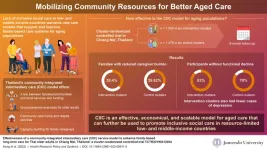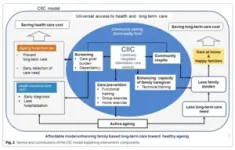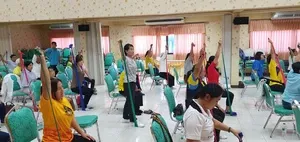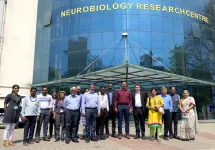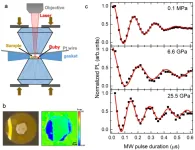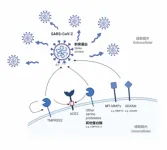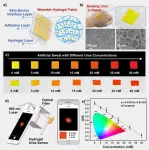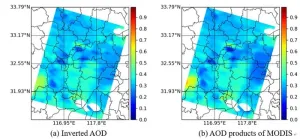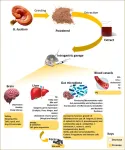Rapidly ageing populations are a problem that many low- and middle-income countries are currently facing. However, for several of these countries, inclusive health and social care is still a pipeline dream. Since older adults require constant attention and monitoring due to age-related morbidities and disabilities, the onus of caring for them usually falls on their families. This often leads to caregiver stress, burnout, loss of working hours, or job loss. Given this increasing burden on family caregivers, it is essential to come up with new approaches to support and strengthen family-based care systems.
To this end, a multi-national group of researchers from Chiang Mai Rajabhat University, Thailand; Tokyo Ariake University of Medical and Health Sciences, Japan; Ministry of Public Health, Thailand; Chulalongkorn University, Thailand; and Juntendo University, Japan have collaboratively proposed a new prevention-based, community-integrated care model that is specially adapted for improving health and social care services in Association of Southeast Asian Nations (ASEAN) countries. The community-integrated intermediary care (CIIC) model is a novel approach for improving access to long-term care service for the aging population. It recruits community services to offer support to the older people, taking some load off of family caregivers. The model was implemented in Chiang Mai, Thailand and its effectiveness was tested through a cluster-randomized controlled trial funded by the World Health Organization Centre for Health Development (WHO Kobe Centre). The results of this trial are collated in a study which was published in Health Research Policy and Systems on 29 November 2022.
A total of 2,788 participants—1,509 in CIIC intervention clusters and 1,279 in control clusters (that had traditional family-based care), were recruited for the trial. The study investigated the effectiveness of the CIIC model in reducing the burden on family caregivers and improving older people’s functional ability and quality of life. The CIIC model combines formal and informal care that can be implemented at a community, district, subdistrict, or city level. It is designed to improve the link between families and communities, and local formal health services and funding by using a multi-tiered collaborative approach. “The CIIC model includes older persons, their families, peer groups, volunteers, community stakeholders, local governments, primary healthcare centers, and public health departments and ministries in Thailand, for more streamlined resource mobilization and sustainable finance,” explains Prof. Myo Nyein Aung from Juntendo University, Japan, the lead researcher of the trial.
The CIIC intervention included three components. The first was encouraging community group exercises and home exercises to preserve the functional ability of the older persons and reduce their care needs and frailty; the second was the delivery of technical training and assistance for family caregivers to improve their care capacity; and the third component was the provision of formal care through a community-level, short-term respite care service center for dependent elders when their family caregivers are temporarily unavailable.
At a 6-month follow-up, it was found that more families showed reduced caregiver burden in the intervention clusters (mean = 39.4%) than control clusters (mean = 28.62%). Similarly, there were more participants in the intervention clusters (mean = 83% and 87.14%) than the control clusters (mean = 78% and 85.89%) without functional decline and depression, respectively.
These results clearly indicate the effectiveness of the CIIC model in preventing an increase in long-term care needs by improving the physical and mental capacities of elders and in reducing the burden of family caregivers through adequate support. Overall, the model enables healthy aging communities. “CIIC is a cost-effective care model that can be scaled up to help actualize universal long-term care coverage, particularly for the aging populations across different countries in Asia, as well as globally. Furthermore, it could play a key role in bettering health and social welfare policies,” envisions Prof. Aung.
The CIIC model offers a promising solution to an urgent problem—securing access to health and social care for the older persons and providing the basic resources necessary for a life of meaning and dignity.
END
Ageing with Grace: New Health and Social Care Model for Older People in Thailand
2023-02-22
(Press-News.org) In several poorer countries, ageing populations and a lack of universal access to long-term care place the burden of care for older adults on their family. To mitigate this, researchers have successfully implemented a community-integrated intermediary care model in Thailand. This care service has proven effective in reducing caregiver burden and improving the functional ability and independence of seniors. The multi-pronged model includes care prevention activities, capacity-building for family caregivers, and community respite services.
ELSE PRESS RELEASES FROM THIS DATE:
Can smart watches and other fitness and wellness trackers do more harm than good for some people?
2023-02-22
Philadelphia, February 22, 2023 – In recent years, wearable devices such as smartwatches and rings, as well as smart scales, have become ubiquitous – “must-haves” for the health conscious to self-monitor heart rate, blood pressure, and other vital signs. Despite the obvious benefits, certain fitness and wellness trackers could also pose serious risks for people with cardiac implantable electronic devices (CIEDs) such as pacemakers, implantable cardioverter defibrillators (ICDs), and cardiac resynchronization therapy (CRT) devices, reports a new study published in Heart Rhythm, the official journal of the Heart Rhythm ...
Shock to the system
2023-02-22
Feb. 22, 2022 — In this high-tech era, wearable devices such as smartwatches have proven to be invaluable companions for the health conscious. But a new study from the University of Utah shows that for a small group of people, some of these electronic fitness gadgets could possibly be risky to their health — even potentially deadly.
University of Utah electrical and computer engineering assistant professor Benjamin Sanchez Terrones and U associate professor of medicine Benjamin Steinberg have published a new study that shows wearable devices such as ...
Promising new ENIGMA study launches to determine factors contributing to brain aging
2023-02-22
As part of an effort to address a diversity crisis in brain research, a USC-led brain research consortium is launching a massive data-gathering initiative in India. By 2050, 79% of the world's population over age 60 will live in developing countries, with 20% in India, according to the United Nations. Yet most brain research has been conducted in Caucasian populations from relatively wealthy backgrounds. This lack of ethnic diversity means that we do not know if predictors of health and disease generalize to other ethnic groups, and researchers struggle ...
Novel quantum detection method developed to solve the problem of in-situ sensitive magnetic measurement under high pressure
2023-02-22
Substances exhibit many novel properties under high pressure, for example, pressure can induce insulator-metal or even superconductor transition. However, in-situ magnetic measurement is always a difficult problem in high pressure research and restricts the study of superconductor's Meissner effect and magnetic phase transition behavior of magnetic materials at high pressures.
A new high pressure in-situ magnetic detection method was developed recently by a collaborated research group of Hefei Institutes of Physical Science (HFIPS) of Chinese Academy of Sciences, ...
HKUMed identifies novel host protease determinants for SARS-CoV-2 infection
2023-02-22
Researchers from Department of Microbiology, School of Clinical Medicine, LKS Faculty of Medicine, the University of Hong Kong (HKUMed), has identified novel host protease determinants, that facilitate the infection of SARS-CoV-2, including the Omicron variant, which provided new targets for combating the pandemic. In addition to the host protease determinants, members from the membrane-type matrix metalloproteinase (MT-MMP) and a disintegrin and metalloproteinase (ADAM) families were found to be able to mediate SARS-CoV-2 entry, with an increase efficiency against Omicron BA.1. This finding suggests that a new treatment strategy at MMP inhibition should be explored to effectively combat ...
Novel method with carbon-coated magnetite nanoclusters proposed in cancer synergistic therapy
2023-02-22
Recently, Prof. WANG Hui, together with Prof. LIN Wenchu and associate Prof. QIAN Junchao from Hefei Institutes of Physical Science (HFIPS) of the Chinese Academy of Sciences reported a NIR- II -responsive carbon-coated iron oxide nanocluster which was guided by magnetic resonance image and capable of combined photothermal and chemodynamic therapy (CDT).
Relevant results were published in SCIENCE CHINA Materials.
As a promising treatment strategy, CDT has become a hot spot in treating cancer because of its simple operation and low side effects. The basic ...
New research reveals 12 ways aquaculture can benefit the environment
2023-02-22
Aquaculture, or the farming of aquatic plants and animals, contributes to biodiversity and habitat loss in freshwater and marine ecosystems globally, but when used wisely, it can also be part of the solution, new research shows.
Published today in Conservation Biology, University of Melbourne researchers have identified 12 potential ecological benefits of aquaculture. These include species recovery, habitat restoration, rehabilitation and protection, and removal of overabundant species.
Lead ...
New approach allows faster test of urea in body fluids
2023-02-22
Recently, a research team from the Institute of Solid State Physics, Hefei Institutes of Physical Science (HFIPS) of Chinese Academy of Sciences developed a wearable sensing patch and realized rapid quantitative analysis of urea.
The related results have been published in prestigious international journal Analytical Chemistry.
Urea, which is excreted through sweat, urine, saliva and blood, is considered an important indicator of renal function in clinical diagnosis. Effective detection of urea level is crucial for early detection of disease. Wearable fluorescence-based sensors have attracted much attention of users, but traditional fluorescent hydrogels ...
Novel algorithm proposed for inversion of aerosol optical depth
2023-02-22
To meet the requirements of single-angle and multi-band polarization aerosol detection, a research team led by Professor SUN Xiaobing from Anhui Institute of Optics and Fine Mechanics, Hefei Institutes of Physical Science (HFIPS), Chinese Academy of Sciences (CAS) proposed an optimal inversion algorithm based on the combined utilization of multi-band intensity and polarization information.
The result was published in Remote Sensing recently.
Aerosol optical depth (AOD) is used to characterize the extinction effect of aerosol on solar radiation, which plays ...
Therapeutic importance of Ganoderma lucidum highlighted in recent review paper
2023-02-22
According to the research published in Food & Functions recently, a team led by Prof. Huang Qing at the Institute of Intelligent Machines, Hefei Institutes of Physical Science (HFIPS), Chinese Academy of Sciences (CAS), reported for the first time an update and a comprehensive summary of the studies on the immunomodulatory therapies and nutritional significance of Ganoderma lucidum (G. lucidum) from 2010 to 2022, and confirmed that G. lucidum is an essential prebiotic for increasing bacterial flora and a health encouraging agent because of its ...
